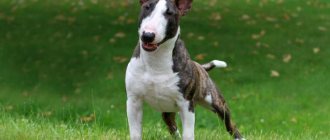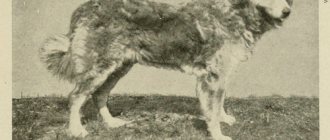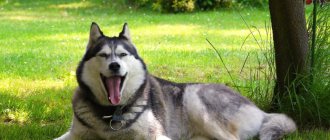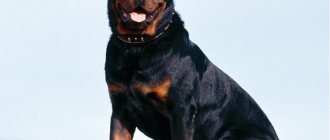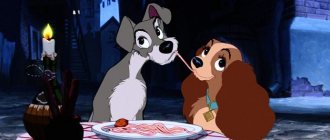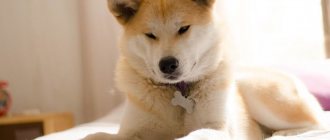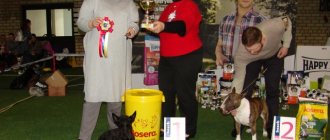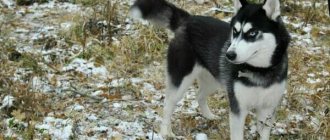History of the Akita Inu breed
According to information from ancient historical sources in Japan, the ancestor of modern representatives of the breed is the Matagi Inu (Matagi is an ethnic group of hunters, inu is “dog”).
The region of origin of the Akita Inu is considered to be Akita Prefecture on the island of Honshu. Matagi Inu and her ancestors served people as indispensable hunting assistants, allowing them to hunt even very large or agile animals: Japanese macaques, bears, wild boars. In the 12th-13th centuries, a new popular entertainment arose in Japan - dog fighting. It became a cruel selection for these dogs, leaving only the strongest, most evil and hardy. In the 19th century, a wave of industrialization swept across the country, many residents moved, and the number of crimes increased. Because of this, the Matagi Inu were retrained to guard property. At the same time, bullmastiffs, mastiffs, and Great Danes were brought from Europe to Japan, reviving the tradition of dog fighting. Increasingly, Akitas were crossed with these dogs to produce more aggressive and larger dogs.
This caused concern among Japanese dog breeders, because the breed began to lose its features, so in 1931 the Akita Inu was transferred to the status of a natural monument at the state level. Breeders are actively engaged in reviving the breed, selecting only the best representatives for breeding. The first official standard was introduced in 1934, but over time it had to be adjusted. Around the same time, the breed received its modern name, and in 1967 a thematic museum was opened.
The Akita Inu suffered serious damage during World War II - these dogs almost disappeared. They suffered from hunger, became victims of barely surviving people, their skins were used for clothing. At the end of the war, a government decree was issued to exterminate all dogs unsuitable for military purposes, since a real rabies epidemic had begun in Japan. For this reason, breeders hid some representatives of the breed in remote settlements, breeding them from the Matagi Inu. Hobbyists also bred hybrid generations of Akita and German Shepherd to adapt them for military service.
After the war, a new round of restoration of the Akita Inu breed began, the greatest contribution to which was made by Morie Sawataishi - it was thanks to him that these unique dogs have survived to this day. Purebred individuals had to be collected all over the country, but it paid off. The American military liked the charming and proud Akita, so the breed was brought to the United States.
A Brief History of the Akita Inu Breed
Officially, the birthplace of Akita Inu dogs is Japan, namely the small city of Akita on the island of Honshu. The history of the breed dates back to the distant 17th century, and modern Akitas owe their origin to the Matagi Inu, dogs known since the 8th century. There is also a version that Akitas originated from a Chinese Spitz dog crossed with a mastiff. There is another opinion that the ancestors of Akita dogs were Siberian Huskies crossed with Mastiffs.
It is unusual that this breed did not appear as a result of selection, but independently - dog breeds considered to be the ancestors of Akita crossed with each other without human help. In addition, the Akitu Inu is the oldest purebred breed: from about the 17th century, when the appearance of the modern Akita was finally formed, the Japanese no longer allowed its crossing with other breeds.
This is interesting! The Akita Inu is one of the 14 oldest dog breeds on the planet. Among them there are also Alaskan Malamute, Basenji, and Afghan Hound.
The name of this dog breed is translated from Japanese very simply: “Akita” is the province where they first appeared, and “inu” means dog.
At first, representatives of the breed were used by peasants as hunters and watchmen. Gradually, around the 18th century, they changed their status to “elite” and became available for purchase only to very wealthy people.
In 1927, a society for the preservation of Akita Inu was created, which was supposed to prevent the mixing of the blood of these dogs with individuals of other breeds. Later, during World War II, the breed's numbers declined sharply. Despite this, Japanese cynologists were able to preserve several purebred individuals, thanks to which the breed retained its qualities. At the end of the war, these dogs were brought by the military to Europe and America, where they became very widespread.
Features of the American Akita
The American branch of this breed appeared precisely after World War II, when US military personnel began to export puppies to their homeland. It is interesting that they were mainly interested in large mestizos, somewhat similar to bears, and not purebred dogs. This played into the hands of Japanese dog breeders, who did not want to share the laboriously recreated breed.
Selection experiments continued in the USA, where they managed to obtain more massive dogs with a menacing appearance - which is why we now have two varieties of the breed with significant differences. The Americans managed to gain recognition from the AKC (American Kennel Club, an organization that registers purebred dogs and new breeds) only after refusing to import new dogs from Japan. This led to a severe limitation of the gene pool, and therefore the development of the breed as such. The Japanese continued to work on colors, since they had a large variability of genes at their disposal. Today, the Akita Inu is considered a good companion, a devoted protector of the owner and his property.
History of the origin of the breed
Today Akita Inu are powerful large dogs, but the ancestors of the breed did not have this size. In the 17th century, in the Akita region there was a breed of medium-sized fighting dogs: the Akita Matagi. Since the mid-19th century, matagi have been crossed with mastiffs and tosa inu, due to which Akitas have become larger. At the beginning of the 20th century, dog fighting was banned, but the breed not only did not disappear, but even improved. In 1931, nine dogs received the title of “Natural Monuments”.
The Akita Inu breed comes from Japan. These are very massive, powerful and reliable dogs. Even hunting large animals is not a problem with them. In former times, this breed was considered a fighting breed, it is worth noting that its representatives have always occupied leading positions in dog fighting, but after this type of “entertainment” became prohibited, they were no longer used for fighting and began to be treated simply as their own pets. favorites.
Individuals of this breed were kept by representatives of the aristocratic class of Akita Prefecture (Japan), located in a mountainous area. In those days, Akita Inus were used to hunt bears and as guards. The breed arose thanks to the efforts of a certain disgraced nobleman, who, having been excommunicated from the imperial court, concentrated all his efforts on working with dogs. Over time, Akita Inu became an indispensable attribute of the aristocratic lifestyle, and the luxury of the leash could be used to judge the significance of the owner’s social status. Each dog was assigned a special caretaker, dressed in a special robe, indicating his belonging to a specific aristocratic house and occupation.
Akita Inu became widespread and became famous only after the end of World War II; they were taken to the United States of America and later dispersed throughout the world. Thanks to their well-developed sense of smell and acute hearing, these dogs are excellent bloodhounds. It's no secret that these dogs will do anything for their owner, they are loyal and reliable, and can survive in any, even the harshest conditions.
During World War II, the breed almost disappeared: the meat was used for food, and the warm fur was used for military clothing. To preserve the breed, the owners bred dogs with German shepherds and took the few Akitas to the mountains. After the war, in the dwindling Akita population, three different types emerged: Matagi Akita, fighting dogs and herding dogs. The situation became confusing. Through the efforts of enthusiasts, the breed's characteristics were restored, and the influence of the blood of foreign breeds was minimized.
Appearance and special features of the breed
The Japanese version is called Akita Inu - these are medium to large sized dogs with a dense, at the same time graceful physique. The head with small ears resembles a fox. Only a few color options are recognized. The fur must be short and there must be a white mask on the muzzle.
The version from the USA is called the large Japanese dog or American Akita. They are exceptionally large dogs with heavy bear-like heads. Almost any variant of suit is recognized, including black or with a dark mask.
general description
Akita Inu thrives in moderate to cold climates. Among the characteristic features:
- fairly large head;
- erect triangular ears;
- strong physique;
- tail curled into a donut.
An adult male has a height of 66-71 cm at the withers, weight from 45 to 59 kg. Females are 61-66 cm tall, weigh from 32 to 45 kg, while their body length is slightly longer than that of males. The Japanese version of the breed is slightly lighter and smaller. Eight-week-old puppies usually have the following parameters:
- large Japanese - weight 8.16-9.97 kg;
- Akita Inu – weight 7.25-9.07 kg.
The growth of dogs is slow; the animal’s development finally ends only by 3 years. Puppies gain weight quite actively (up to 7 kg per month); after reaching 35-49 kg, their development slows down greatly, but does not complete until the age of three. Don't worry if your pet doesn't quite fit into existing growth charts as these are very general guidelines. In general, the dynamics are as follows:
- 6 weeks – the puppies are large and very charming, little like adult dogs;
- 6 months – body proportions change, the dog becomes more toned, the puppy roundness disappears, characteristic features are more clearly defined;
- 1 year – bitches begin to heat, but they cannot be considered adults;
- 1-2 years – the growth process slows down greatly, but the transformation of the body continues, especially in the head area;
- 2 years – the dog stops growing in height, expands slightly in width, small changes will continue for another year.
Wool
The classic standard is a dense short coat (about 5 cm), which is slightly longer on the neck and tail. The coat is erect, made of coarse guard and needle-like hairs, the undercoat is very thick and downy. Akita Inu can only have this color:
- pure white;
- red with white fragments and mask (urajiro);
- brindle, also with urajiro;
- red with black tips of hairs (sesame).
The American Akita comes in any color. Long-haired dogs are often born - this is a consequence of a combination of recessive genes from the father and mother. They are the same in character, but do not fit into the standard, therefore they are considered a reject.
Ears
In puppies, the ears are drooping, while in adult dogs they are erect, facing forward and slightly to the sides. They do not accept this position immediately, and this is influenced by two factors:
- age - only as you grow older and strengthen the special muscles, the ears will begin to rise. Chewing and gnawing on toys can speed up this process;
- change of teeth - until permanent teeth appear in place of milk teeth, the ears will not rise completely.
It often happens that they fall back or only one ear is erect. This process takes from 10 weeks to 6 months, so there is no need to worry until six months - the position of the ears will level out.
Eyes
The eyes are brown (preferably as dark as possible), small, deep-set. They have a triangular "oriental" shape that is noticeable from birth. For dogs of light color, black “eyeliner” is allowed, which only emphasizes the special cut.
Tail
In purebred dogs it is fluffy, thick, and rolled into a tight ring. Babies have a straight tail that curls during the first 2 months of life. If the dog is sleeping or just relaxed, it may unwind slightly, but it never becomes straight. Visually and to the touch, this part of the body does not change even during the molting period. The fluffy “donut” tail seems to balance the pet’s large head.
Paws
The description of the paws differs little for different standards: straight, arched, with thick pads, similar to a cat's. Both varieties of Akita have tightly closed toes, which gives them the ability to swim well. In this case, not only the forelimbs are involved, but also the hind limbs. However, most dogs of this breed do not like to swim, entering the water only when absolutely necessary.
Description of the breed
The current breed standard was approved in 2001. Akita Inu are large dogs with a balanced and strong build. These dogs are modest, but with a developed sense of self-esteem. The height of males is 64-70 cm, females -58-64 cm.
- The Akita Inu's head is proportional to the body, the forehead is wide, and there is a clear hollow in the middle. Skin without wrinkles. The transition from forehead to muzzle is well defined. The muzzle is powerful, wide at the base, narrowed towards the nose, but not pointed. The muzzle of the Akita Inu is very similar to that of a bear.
- The ears are relatively small, thick, erect, triangular. The tips are somewhat rounded. Set moderately wide and tilted forward, visually continuing the line of the neck.
- The eyes are relatively small, almost triangular in shape, as the outer corners are raised towards the ears. The eyes are moderately spaced, the eye color is dark brown (the darker the better). The Akita Inu has a straight nose. The nose is large and black. Small areas of scattered depigmentation are permissible only with a white coat; the black color of the lobe remains preferable.
- Dogs have a scissor bite, powerful teeth, and moderately developed cheekbones. Lips fit tightly.
- The body of dogs is strong and powerful. The neck is muscular, without dewlap. The stomach is taut. The chest is deep, with moderately arched ribs and a developed forepart. The back of the Akita Inu breed is straight, strong, the lower back is muscular and wide.
- The Akita Inu's forelimbs are straight, with strong bones, the shoulders are moderately sloping, the elbows are tightly pressed to the body. The paws are round and balled, the pads are thick, the toes are arched.
- The hind limbs of the Akita Inu are well developed, with powerful muscles. The paws, like the front paws, are round in shape, with toes gathered into a ball and thick pads.
- The tail is thick, set high and carried over the back. Shapes from sickle to double ring are acceptable. When the dog lowers its tail, the tip reaches almost to the hock joints.
- The Akita Inu has a two-layer coat. The undercoat is thick and soft, the outer coat is straight and hard. On the withers and rump, tail and “pants” the hair is slightly longer than on the dog’s body.
We advise you to read: Pomchi Dog Breed
The color of the Akita Inu can be red-fawn, sesame type (black tips on red-fawn hair), brindle and white. Dogs of all colors, with the exception of white, must have "urajiro". This is white hair on the cheekbones, sides of the muzzle, lower jaw, chest, neck, tail, belly and inner surfaces of the legs.
Akita Inu character
It is difficult to briefly describe the character of this breed. Akitas are very versatile dogs. The American subspecies is distinguished by more serious habits, the Japanese are somewhat more playful and frivolous. At the same time, most representatives of the breed are not stupid sofa pets or overly gloomy dogs. There are several main character traits.
- Own independent thinking - this is often mistaken for stubbornness, but in fact it is enough to establish mutual understanding.
- The sense of hierarchy is very developed, so they try to establish a rank in relation to the owner’s other dogs. It is important to achieve recognition of the person as the leader within the first weeks and months of the dog’s life, otherwise he will dominate.
- Trainability – Akita Inu dogs quickly grasp new knowledge and skills, so they begin to get bored if they repeat the same thing for a long time. It is very important for them to understand why they perform certain tasks, so it is worth taking care to develop the right motivation.
- No fear of heights - it is worth blocking off the balcony and other dangerous places, because puppies are very brave and not too smart. Adult dogs jump high, caring little about where they land.
- Craving for space - they like to run a lot, frolic in nature, and visit new places. Physical activity is vital for them.
- Tenderness – mentally these dogs are very sensitive, they are easily offended.
- Loyalty to the owner - the Akita will not pester or interfere with everyday activities or recreation, but they are very loyal creatures. They love to quietly follow their owner everywhere.
- Patience – despite being dominant, a properly trained dog is incredibly patient. She will modestly wait for you from work or sit quietly by the bed, waiting for you to wake up.
- Attitude towards other people - Akita gets along well with older people. The attitude towards children depends on their behavior and family affiliation.
- Attitude towards dogs - if the other dog is smaller and lives in the same family, there will most likely be friendship. Relationships with representatives of the same species and the same sex, completely alien dogs, are difficult. Aggression (at least in the form of growling) is especially active if the second pet is of the same or larger size.
- Fear of small spaces – Akita Inu dogs do not like too cramped enclosed spaces. They try to get a good view and control of the space.
- Aggression – these dogs are very sensitive to the relationship between guest and owner. Welcome visitors need not worry. Such dogs do not like strangers, so they will closely watch the guest until they understand how appropriate his presence is in the house. Only proper training will help manage innate aggression.
- Security - they are good guards, but they do not immediately rush to bite. For example, they will simply try not to let a thief leave the house, waiting for the owner’s help.
- Barking dogs are fairly quiet dogs, but they are very sensitive to new people, animals and sounds, and are able to use their voice to issue a warning to someone who is invading their territory.
History of the origin of the Akita Inu breed
The history of the Akita Inu breed dates back to Ancient Japan. Scientists have proven that it is one of the 14 oldest dog breeds in the world. In addition, the remains of this dog dating back to the 2nd millennium BC were found in Japan. e.
The original name for us is actually nothing more than a combination of two simple words: “inu” - a dog, and “Akita” - the name of a mountainous province in Japan. This breed was officially introduced in the 17th century, and since then the characteristics of the Akita Inu, as well as the description of the external data, have not changed. For many years, these dogs were favorites not only of influential statesmen and the aristocracy, but also of emperors. If initially this breed of dogs was bred exclusively as hunters, and these dogs lived among peasants, then in the 18th century the breed acquired an elitist character. Now Akita Inu could be seen among the wealthiest segments of the population.
Interestingly, the popularity of this breed was so widespread that Japan even passed a law prohibiting anyone from harming, much less killing, an Akita Inu . Anyone who committed such an atrocity would certainly be punished. Since this long-haired breed was in great demand among the aristocracy for several centuries, even the process of caring for a four-legged pet was more like an elaborate ceremony. Each dog had its own servant, and leashes and collars were purchased depending on the social status of the owner.
Related article: Main differences between Shiba Inu and Akita Inu
Another interesting fact: in 1927, a special Akita Inu Conservation Society was created in Japan. Preserving the Akita Inu standard and doing everything to ensure that the breed is not translated is the key task of the members of this organization. Over all these years, the breed has changed a little, but has retained its main characteristics.
Care and maintenance
Despite its dislike for confined spaces, the Akita Inu is well suited both for living in a city apartment and for keeping in a private house. In any case, it is extremely important to provide long walks during which the dog can realize his energy. Start exploring the world around you after completing all vaccinations.
- Walk around the area and beyond, change routes every day.
- Visit both quiet and noisy places so that the dog gets used to as many situations as possible (park, forest, shops, beach, market, pet store, square). In the future, when she gets into a crowded place, she will not experience serious stress.
- During walks, keep your Akita on a leash, showing leader control.
- Although this breed does not like other dogs, teach them to behave calmly. When meeting another pet on a leash, let them get to know each other and sniff each other. If everything goes well, don't interfere. If aggression or growling occurs, separate the dogs.
- Teach your dog to travel in the car - start with trips of 5-10 minutes a day, gradually increasing this time to 35-45 minutes.
Features of care
Akita Inu sheds heavily twice a year: from January to February and from May to June. During this period, the dog must be brushed every day or at least 3-4 times a week. The rest of the time, brushing 4 times a month is sufficient. Constant shedding is possible in a house with very warm and dry air. Another reason is illness or poor diet. There is no need to cut or trim your pet's coat. There are other care recommendations.
- Bathe your dog no more than 1-2 times a year so as not to wash off the special protective lubricant of the coat. These dogs are very clean themselves, they know how to lick themselves, and the rest of the dirt will be removed during brushing.
- Brush your pet's teeth 1-2 times a week. Use only a special product.
- Regularly examine your Akita's eyes and ears to notice inflammation, discharge or an unpleasant odor - all this indicates the need to urgently visit a veterinarian.
- Trim your nails every month if they don't wear down naturally.
Accustom your dog to any procedures while still a puppy. You may simply not be able to cope with an older dog or it may cause stress and loss of trust.
Akita Inu Health and Diseases
This breed is in good health, provided that the puppy does not have any serious congenital defects. Sometimes they suffer from genetic diseases and are sensitive to certain medications. Among congenital and acquired/age-related ailments there are:
- entropy (inversion of the eyelid);
- hip dysplasia;
- bloating;
- glaucoma;
- cataract;
- pseudoparalytic myasthenia (weakness of all muscles of the body);
- von Willebrand disease (blood pathology);
- retinal atrophy.
How to choose a puppy
You can buy purebred puppies only from large, reliable breeders. The main signs of a healthy Akita Inu baby:
- active and cheerful;
- puppy of average fatness;
- beautiful shiny coat;
- runs confidently, stands firmly on its paws;
- not aggressive, not afraid of loud sounds.
Pay attention to the color and shape of the Akita Inu's eyes - if they are round and light, this is not a purebred pet. Features of the shape of the eyes are necessarily congenital, and the color changes with age only to a lighter color. The bite must be correct, the pigmentation of the nose and mouth must be uniform. If you buy a puppy older than six months, and its tail has not yet curled, this is a bad sign. If you plan to participate in competitions and exhibitions, then it is better to choose a baby with an experienced dog handler. When purchasing an ordinary pet, it is enough to use the criteria outlined above.

